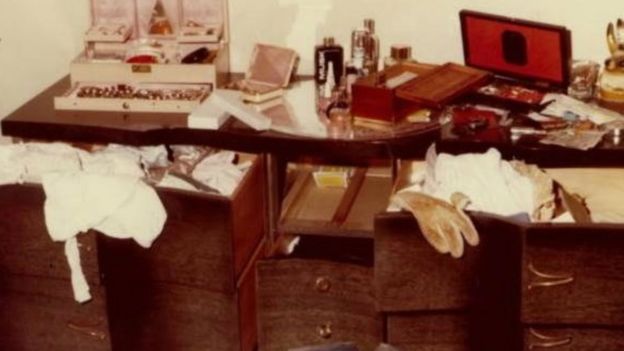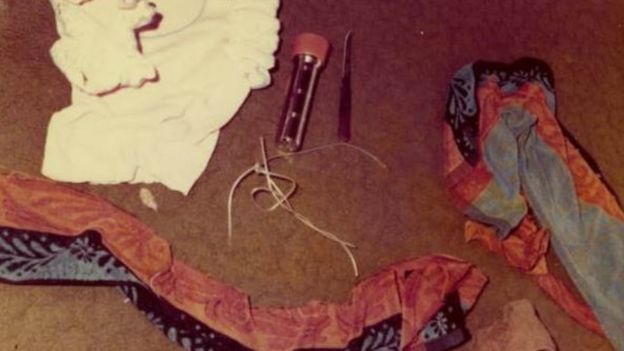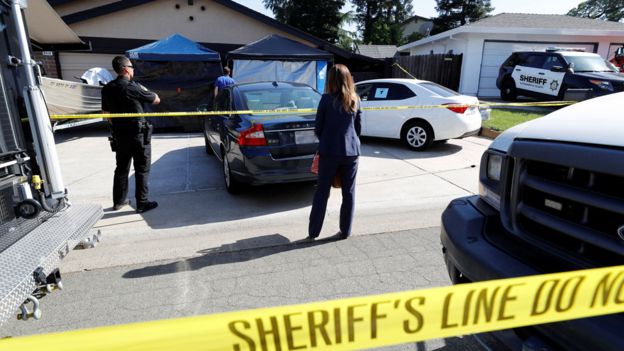Police say the Golden State Killer has committed at least 12 murders, 45 rapes and hundreds of home break-ins all over California. This week they arrested a man they think is responsible. How has the perpetrator of such shocking crimes eluded capture for over 40 years?
Cruz, an 18-year-old restaurant worker, invited a friend over, who later recalled being startled at least twice by strange noises outside and in the garage. But the teenager – described by her family as a kind-hearted, beautiful girl just at the start of adulthood – dismissed the sounds, and her friend left near midnight.
The next morning, a real estate agent coming to show the home discovered Cruz in her bedroom. She’d been raped and bludgeoned to death, her teeth shattered and her face bloodied beyond recognition. There were tennis shoe prints in the soil outside the house and a heavy wrench missing from the backyard.
Investigators initially honed in on the last people to see Cruz alive and her former boyfriends, but the case went cold. Although police assembled a rape kit, DNA testing of crime scene evidence was in its infancy, and the kit was placed in storage for many years.
Meanwhile, the Cruz family tried to get on with their lives, but the thought of Janelle’s killer walking free terrorised them.
“I haven’t been home alone in my house for 32 years,” says Michelle Cruz White, Janelle’s younger sister. “I’ve been living in fear and my mom, too.”
They didn’t know it in 1986, but Janelle was the last known victim of the Golden State Killer, ending the decade-long crime spree of one of the most sadistic serial killers and rapists in American history.
Since the early 1970s, an unknown assailant had been terrorising various parts of California from Sacramento to south of Los Angeles, earning him different nicknames in each crime spree: the “Vidalia Ransacker”, the “East Area Rapist” and the “Original Night Stalker”.
It wasn’t until the advent of DNA testing that law enforcement realised they were dealing with a single perpetrator. And even then, it took another two decades to find him.
“This is a piece of our history that generations of investigators have worked towards,” says Sacramento County Sheriff’s Department Sergeant Shaun Hampton.
 Image copyrightCOURTESY MICHELLE CRUZ WHIE
Image copyrightCOURTESY MICHELLE CRUZ WHIEOn 18 June 1976, a masked intruder broke into the bedroom of a 23-year-old woman who awoke to find him standing over her, naked from the waist down. He bound her hands, stuffed a nightgown in her mouth, and raped her at knifepoint. After he left, she managed to dial 911 with her still-bound hands.
She was just the first – over the next 12 months, the man who became known as the “East Area Rapist” struck again and again, sometimes within days of a previous attack. He often selected single-story homes, accessed them by climbing through windows, and bound his victims’ hands. He blinded women with a flashlight and threatened to kill them.
“There’s something wrong with him,” the first victim told the FBI years later. “There’s something not wired right for someone to do this continually.”
Newspaper headlines from the time illuminate the relentless and prolific nature of the attacker: “Coordinated hunt will begin for attacker of 11 women.” “East Area Rapist Claims 15th Victim; No ID.” “Rapist Strikes for 26th Time; Still No Clues.”
The case seeped into the daily lives of average Sacramento residents, who started arming themselves with guns and baseball bats, buying guard dogs and locking doors for the first time. David Caraccio, online news editor for the Sacramento Bee newspaper, remembers that when he was 12 years old, the East Area Rapist had struck a home near his.
“We jumped on our bikes out of curiosity, we checked out the home,” he recalls. “The news stories aren’t exaggerating how big an impact it had.”
The EAR, as he became known for short, also behaved in terrifying and sadistic ways. He took trophies from his victims – pieces of jewellery, cufflinks. Before he raped a 13-year-old girl, he placed dinner plates on the back of the girl’s mother in a separate room, and warned he would cut the daughter’s fingers off if he heard the plates clatter. In a recorded call to one woman, a man believed to be the EAR whispered over and over again, “Gonna kill you. Gonna kill you.”
 Image copyrightCOURTESY FBI
Image copyrightCOURTESY FBIThe EAR raped over two dozen women by the time he committed his first known murder in 1978.
Katie and Brian Maggiore were out for a walk with their dog on the night of 2 February 1978, when they had a violent confrontation with a strange man. No-one knows what was said, but by the end of it, both 20-year-old Katie and 21-year-old Brian were dead from gunshot wounds. A man wearing a ski mask was seen fleeing by several witnesses.
Katie had complained in the months before that a man was stalking her at her work. Her colleagues said someone called Katie repeatedly, saying, “Your turn is coming.” A strange man sitting in a blue Volkswagen would watch her for hours. After she attempted to confront him, he drove off, only to return hours later. Katie quit her job soon afterwards.
After the Maggiore murders, the EAR moved his hunting grounds to nearby Contra Costa County, committing 20 more rapes before he killed again, this time an osteopathic surgeon named Robert Offerman and his girlfriend, Alexandria Manning. Both were bound and shot in Offerman’s home.
From there on, none of the EAR’s victims were allowed to live. At the dawn of the 1980s, a perpetrator known as the “Original Night Stalker” began killing in Santa Barbara, Ventura and Orange counties. He seemed to develop a new taste for raping women in front of their partners before executing them both.
He murdered married couple Lyman and Charlene Smith, newlyweds Keith and Patti Harrington, and Cheri Domingo and her boyfriend Greg Sanchez. The Smiths were bludgeoned with a fireplace log.
 Image copyrightCOURTESY FBI
Image copyrightCOURTESY FBIHe also raped and killed a woman named Manuela Witthuhn while her husband was at a nearby hospital in 1981. Finally, in 1986, he raped and beat Janelle Cruz to death, before disappearing without a trace for the next 32 years.
The fact that the rapes and murders occurred sometimes hundreds of miles apart stymied investigators, who were accustomed to going straight to the most likely suspects – spurned lovers, family members or acquaintances of the deceased. The lack of DNA technology also meant law enforcement had much less to work with.
“We had excellent investigators back in those days who worked really hard on the case,” says Lieutenant Paul Belli, who has been assigned to the case since 2008. “Nobody could have predicted that the southern California cases were our guy.”
Janelle Cruz had been dead for a decade when it was discovered that the DNA sample from her body matched DNA from the Harringtons and Manuela Witthuhn. Over time the DNA profile also matched with the Domino and Sanchez murders, and the Smiths, as well as to two Contra Costa County rape cases from the late 1970s.
 Image copyrightCOURTESY FBI
Image copyrightCOURTESY FBIAlthough law enforcement has had a DNA profile for the Golden State Killer for decades now, a matching profile was never found in any national DNA database, meaning the man had never been caught for a subsequent crime where his DNA would have been collected.
Eventually a task force joined all the affected jurisdictions together with the FBI to try to collaborate, offer new reward money and send out a call for tips to the public. Although journalists and armchair detectives have been fascinated by the case and offered thousands of tips over the years, no suspect has ever matched the DNA profile, until two weeks ago.
On Wednesday, 25 April, Sacramento County District Attorney Anne Marie Schubert announced that 72-year-old Joseph James DeAngelo had been arrested and charged with the murders of the Smiths, the Harringtons, the Maggiores, Manuela Witthuhn and Janelle Cruz. Additional indictments are forthcoming.
The night before, rumours ripped through the community of survivors and family members that an arrest had been made. The lead detective on Janelle Cruz’s case called Michelle Cruz White and their mother on speaker phone to deliver the news.
“I cried. I cried,” says Cruz White. “My mom’s jaw dropped. She was in shock.”
 Image copyrightGETTY IMAGES
Image copyrightGETTY IMAGESThe break came after Paul Holes, a retired investigator with the Contra Costa District Attorney’s Office and long time investigator on the case, searched a free, do-it-yourself genealogy website called GEDmatch.
According to the Sacramento Bee, the site is a place for people to find long lost relatives, and has a database of 800,000 DNA profiles. Sacramento District Attorney Chief Deputy Steve Grippi confirmed that a family member of DeAngelo’s had used the service, and they were able to isolate him as a suspect and collect “discarded” DNA on two occasions. They finally had a match.
“We were looking for a needle in a haystack and we found it,” says District Attorney Schubert, who has had some role on the case since she was a deputy district attorney in 2000.
DeAngelo is a former police officer with the Auburn Police Department who was fired after he was caught shoplifting a hammer and dog repellent from a hardware store in 1979. He married and had a daughter, and worked as a truck mechanic for a grocery store chain for 27 years.
Sheriff Scott Jones told the Sacramento Bee that DeAngelo was “very surprised” when he was arrested.
Since the arrest, officers from all the jurisdictions touched by the Golden State Killer flocked to the quiet street in Citrus Heights to begin an exhaustive search of the house.
Speaking from outside the home, Lieutenant Belli said they are searching for any trophies the GSK is believed to have collected from his victims over the years, as well as ski masks and firearms.
“We’re trying to go through it, obviously, with a fine toothcomb,” he says.
DeAngelo appeared in a Sacramento courtroom for the first time on Friday. He sat in a wheelchair dressed in an orange prison uniform and spoke in a whisper. He did not enter a plea and has been assigned a public defender. His next court appearance is scheduled for 14 May.
It has not yet been determined if the case will be consolidated into a single jurisdiction, or whether the state will seek the death penalty.
In the meantime, the Sacramento Sheriff’s Department is calling for any additional sexual assault victims who may not have come forward at the time to contact law enforcement.
 Image copyrightREUTERS
Image copyrightREUTERS“This investigation will be ongoing for a very long time,” says Sergeant Hampton.
Michelle Cruz White choked up while speaking to the BBC by phone, the first time she has broken down since finding out that her sister’s rapist and murderer may have finally come to justice, she says.
She says she’s finally able to process how the case has affected her life, and the arrest has validated her decision two years ago to come out publicly and speak about the murder.
“[My family] thought by me showing my face to the world I was jeopardising our entire family, putting us all in danger,” she says. “I just felt so relieved that it’s over and my sister can rest in peace.”
DeAngelo may yet argue his innocence.
But after this arrest, Cruz White says she will finally be able to relax, for the first time in 32 years.
“All his secrets are going to be told to the world. He can no longer hide and die in peace,” she says. “We did it. He’s where he needs to be.”
Source: BBC.com


